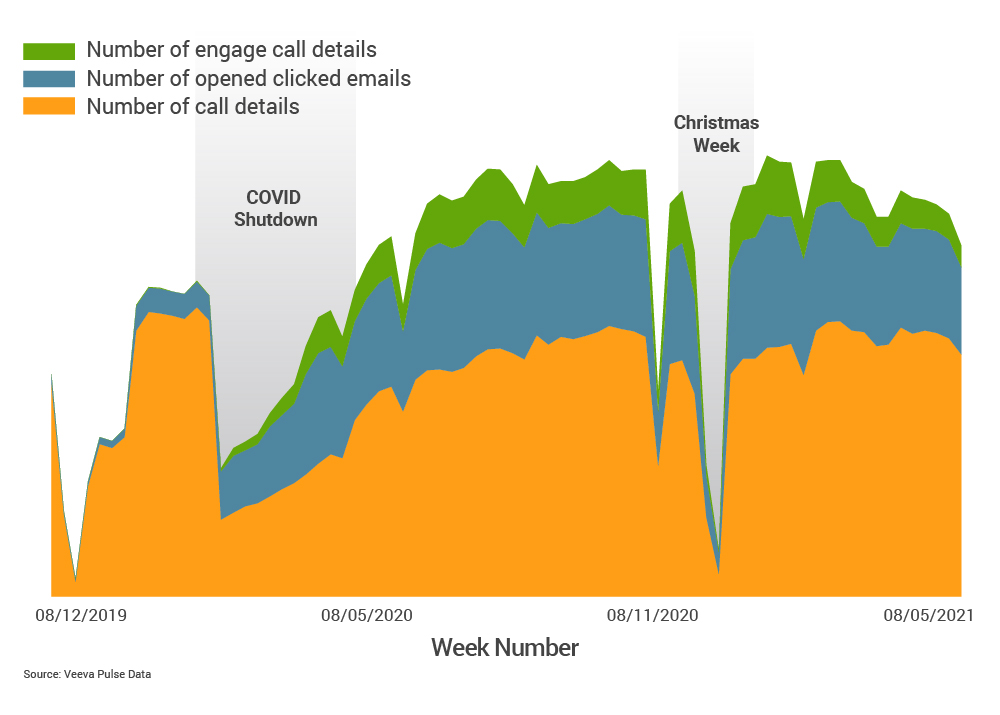With the Delta variant now rapidly spreading across the country, commercial teams are once again finding themselves in reactive mode as they evaluate local situations and how best to maintain contact with healthcare professionals (HCPs). Whether the pendulum swings back toward 100% virtual or a blend of in-person and remote engagement, one thing is clear: the best way to be prepared is to embrace a hybrid engagement model.
In fact, earlier this year, that’s exactly the direction the industry was headed as reps increasingly started making in-person calls while continuing to engage virtually. If current trends continue, we’ll likely be seeing a permanent shift to roughly 80% of engagements happening in person and 20% happening through digital channels.

This new hybrid approach is giving HCPs greater flexibility to meet when and where they want, but it’s also forced sales teams to prioritize channels and reevaluate the effectiveness of their communications activity. When reps are interacting in different channels with HCPs who have different preferences for how they want to engage, how exactly do you define what “good” engagement looks like? And how do you set goals and expectations with field teams when engagement can take on myriad forms?
While the answer may not be as simple or straightforward as sales leaders may like, they can take some concrete actions to get the insights they’re looking for. Here’s how to identify the best channel mix for your customers and why hybrid engagement is good for HCPs and the industry.
Foundational Elements of Effective Engagement
Before you’re able to determine what good looks like, you first need the right foundation in place to enable accurate measurement. At a basic level, the three key requirements commercial teams need are:
- Availability of multiple channels: Do reps have access to a variety of in-person and digital channels, including virtual meetings, email, text, and more?
- Proficiency of reps to operate in multiple channels: Do all reps have the necessary skills, training, and content to use each channel appropriately?
- Closed-loop data: Do field teams have access to channel preference and engagement data to drive next best action? And can HQ teams leverage the data for strategy and planning?
 With these foundational elements, the data analysis can begin—and that’s when the interesting patterns emerge. However, this is where most companies stop and wonder: at what level should we be analyzing the data? From a national level? By brand or therapeutic area?
With these foundational elements, the data analysis can begin—and that’s when the interesting patterns emerge. However, this is where most companies stop and wonder: at what level should we be analyzing the data? From a national level? By brand or therapeutic area?
It may be tempting to go with this top-down view, where overarching trends are identified and used to create a one-size-fits-all approach across a broad group of HCPs. But the reality is that each HCP is going to be different, and reps need to take these individual preferences into account when figuring out how best to engage.
The definition of “good” will vary by customer, and that means a bottoms-up view of engagement will paint a much clearer picture. Companies should look at HCP preferences and behavior at the prescriber level and use that data to educate reps on the best way to engage their specific set of customers.
Identifying Effective Channels by HCP
Having access to this personalized level of data is important; it not only gives your team insights into HCP preferences, but more importantly, what is promotionally effective. You can identify the exact blend of channels that is going to get physician X to write a script.
Commercial teams can get especially precise in identifying what works by looking at data not just from their own company, but at industrywide engagement data as well. With a prescriber-level view that spans across companies, field teams can understand what’s been effective, not just for them, but for competitors and adapt their strategies accordingly. Fully incorporating channel effectiveness data can have a positive impact on call planning, workload management, and field territory design.
In an ideal scenario, reps would know the best way to reach the top 20% of their targets, including what type of engagements would be most likely to generate prescriptions. While it may take a while for companies to get there, the payoff will make up for the initial time and investment required to understand individual customer preferences and behaviors.
Turning Insights into Action
Until then, companies can start making incremental improvements to engagement by incorporating user-friendly dashboards into their CRM system. Reps can use these data visualizations to get tailored, actionable insights that help them determine the next best action with each customer.
Another way to simplify the process for HQ is to be as prescriptive as possible in the call plan. For example, if physician A is a high digital engager, specify in the plan that 25% of their calls should be done virtually, whereas physician B who is a low digital engager, should be getting 0%. Not only will this help with coaching, but it will improve expectation setting as well.
Finally, companies should consider standardizing call metrics in their CRM system, ideally in the same way as the rest of the industry. Make sure reps are specifying which interactions they’re having via remote meetings, in-person visits, email, phone, and other channels, so it’s easier to pinpoint behavioral patterns and preferences across a broad, industrywide data set.
Why You Need Quality Over Quantity
One of the common pitfalls of defining what good looks like is an overreliance on the quantity of engagements over quality. The industry faced a similar problem back in the ’90s when reps were appearing in droves at the physician’s door. An HCP would come into the waiting room only to find three patients and five reps competing for their attention—which of course, inevitably led to push back from doctors.
Companies should make a conscious effort to not go back to that, with an approach that is measured not by call volume but by individual HCP preferences. For example, instead of relying on a quantity benchmark, come up with a blended quality score that includes things such as rate of sampling against HCP, digital content consumption, and repeat visits within a particular time period. This will ensure teams are paying attention to the metrics that matter versus defaulting to productivity key performance indicators (KPIs) that may not be having any measurable business impact.
Everyone wishes it was as easy as identifying a single, off-the-shelf metric that works for all customers (e.g., seven calls, three emails with a 50% open rate, and two virtual meetings/week). But each HCP is different, and in order to accurately identify what’s driving prescriptions and customer satisfaction, a bottoms-up approach that puts customer needs first is required.
It’s All About Customer-Centricity
HCP engagement in the U.S. has now entered full hybrid mode. Reps are leveraging a mix of call channels, and with this proliferation of promotional tactics, comes a newfound ambiguity around the best way to reach HCPs.
While defining what good looks like in this new environment may not be easy, the good news is that by taking the time to identify what works at the prescriber level, companies will be able to deliver a more personalized—and ultimately, effective—approach to engagement. With greater customer-centricity, relationships will strengthen, HCP satisfaction will increase, and more patients will get access to the critical drugs they need.








